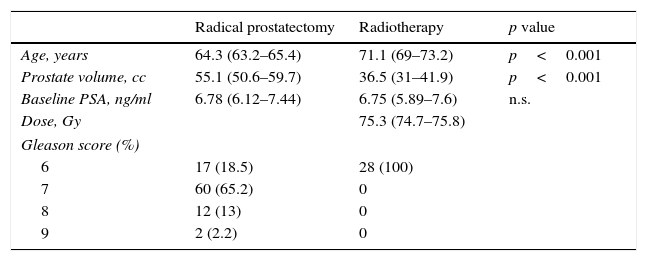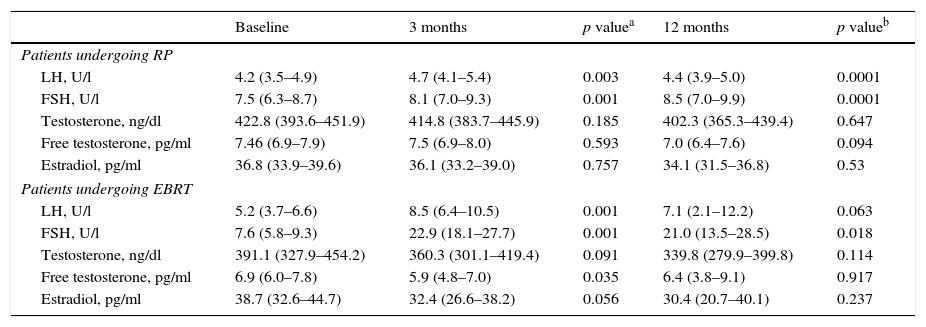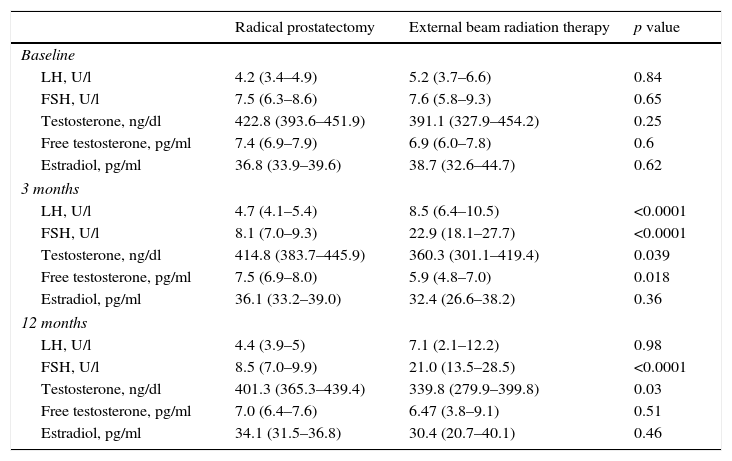To determine the influence of radical prostatectomy (RP) and external beam radiation therapy (EBRT) on the hypothalamic pituitary axis of 120 men with clinically localized prostate cancer treated with RP or EBRT exclusively.
Materials and methods120 patients with localized prostate cancer were enrolled. Ninety-two patients underwent RP and 28 patients EBRT exclusively. We measured serum levels of luteinizing hormone, follicle stimulating hormone (FSH), total testosterone (T), free testosterone, and estradiol at baseline and at 3 and 12 months after treatment completion.
ResultsPatients undergoing RP were younger and presented a higher prostate volume (64.3 vs. 71.1 years, p<0.0001 and 55.1 vs. 36.5g, p<0.0001; respectively). No differences regarding serum hormonal levels were found at baseline. Luteinizing hormone and FSH levels were significantly higher in those patients treated with EBRT at three months (luteinizing hormone 8.54 vs. 4.76U/l, FSH 22.96 vs. 8.18U/l, p<0.0001) while T and free testosterone levels were significantly lower (T 360.3 vs. 41,483ng/dl, p 0.039; free testosterone 5.94 vs. 7.5pg/ml, p 0.018). At 12 months FSH levels remained significantly higher in patients treated with EBRT compared to patients treated with RP (21.01 vs. 8.51U/l, p<0.001) while T levels remained significantly lower (33,989 vs. 40,239ng/dl, p 0.03).
ConclusionsProstate cancer treatment influences the hypothalamic pituitary axis. This influence seems to be more important when patients with prostate cancer are treated with EBRT rather than RP.
More studies are needed to elucidate the role that prostate may play as an endocrine organ.
Determinar la influencia de la prostatectomía radical (PR) y de la radioterapia externa (RT) sobre el eje hipotálamo-hipofisario de 120 pacientes con cáncer de próstata clínicamente localizado tratados con PR o RT exclusiva.
Material y métodosEstudiamos 120 pacientes con cáncer de próstata localizado. Noventa y dos pacientes recibieron PR y 28 RT exclusiva. Medimos los niveles séricos de hormona luteinizante, hormona folículo estimulante (FSH), testosterona total (T), testosterona libre y estradiol basalmente y a los 3 y 12 meses tras completar el tratamiento.
ResultadosLos pacientes sometidos a PR eran más jóvenes y presentaban mayor volumen prostático (64,3 vs. 71,1 años, p<0,0001 y 55,1 vs. 36,5 g, p<0,0001; respectivamente). No encontramos diferencias en los niveles hormonales basales. Los niveles de hormona luteinizante y FSH eran significativamente superiores en los pacientes tratados con RT a los 3 meses (hormona luteinizante 8,54 vs. 4,76 U/l, FSH 22,96 vs. 8,18 U/l, p<0,0001) y los niveles de T y testosterona libre significativamente inferiores (T 360,3 vs. 414,83ng/dl, p 0,039; FT 5,94 vs. 7,5pg/ml, p 0,018). A los 12 meses los niveles de FSH permanecían significativamente superiores en los pacientes tratados con RT comparado con pacientes tratados con PR (21,01 vs. 8,51 U/l, p<0,001) y los niveles de T permanecían significativamente inferiores (339,89 vs. 402,39ng/dl, p 0,03).
ConclusionesEl tratamiento del cáncer de próstata influye en el eje hipotálamo-hipofisario. La influencia parece más importante en los pacientes tratados con RT.
Necesitamos más estudios que eluciden el papel que la próstata puede jugar como órgano endocrino.
Artículo
Comprando el artículo el PDF del mismo podrá ser descargado
Precio 19,34 €
Comprar ahora










